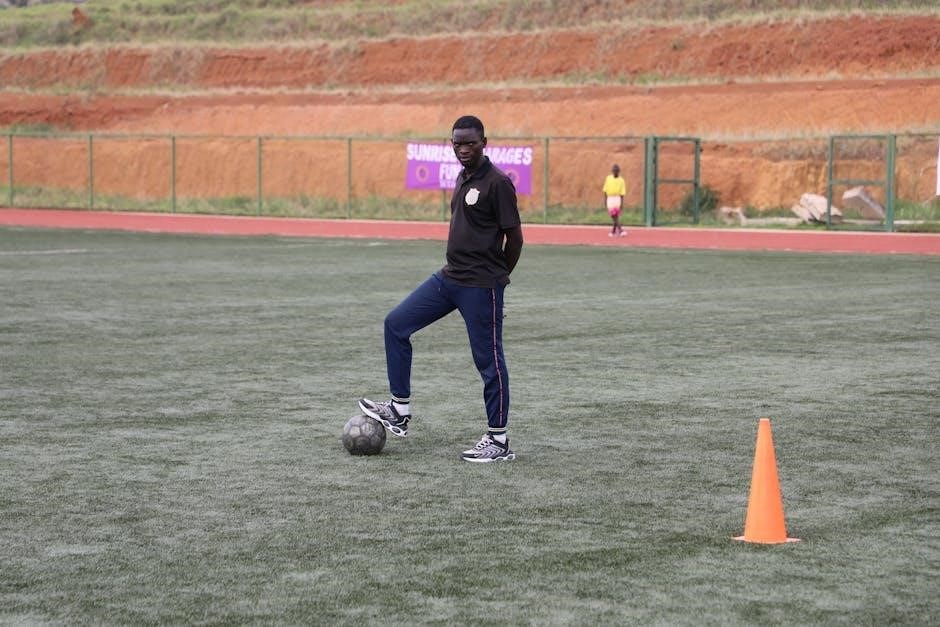12 week 400m training program pdf

This structured 12-week program is designed to enhance speed, endurance, and technique for 400m athletes. It progresses through foundation building, power development, and race-specific preparation to peak performance.
1.1 Overview of the Program Structure
The 12-week 400m training program is divided into three distinct phases, each lasting four weeks. Phase 1 focuses on building foundational speed and endurance through sprint drills and aerobic workouts. Phase 2 emphasizes power and speed development with high-intensity interval training and strength exercises. Phase 3 concentrates on race-specific preparation, including lactate threshold workouts and mental readiness. The program integrates speed, endurance, and strength sessions, with strategic rest days to ensure recovery. This balanced approach ensures athletes progressively build fitness, leading to peak performance by week 12. Each phase is designed to address specific physiological and technical demands of the 400m event.
1.2 Importance of a Structured Training Plan
A well-structured training plan is essential for achieving optimal performance in the 400m event. It ensures consistency, progressive overload, and mental preparedness. Without structure, athletes risk overtraining, under-recovery, or inconsistent progress. A structured plan provides clarity, allowing athletes to focus on specific goals each week. It also minimizes the risk of injury by balancing intense workouts with recovery. Additionally, it helps athletes develop discipline and accountability, which are critical for reaching peak performance. A structured plan is the foundation for maximizing potential and ensuring athletes are prepared to compete at their best when it matters most.
1.3 Benefits of a 12 Week Training Cycle
A 12-week training cycle provides a balanced approach to improving 400m performance. It allows for progressive overload, enhancing speed, endurance, and technique without overtraining. The structured timeline enables athletes to adapt to increasing demands, reducing injury risk. Specific phases ensure comprehensive development, from foundational fitness to race-specific skills. This cycle also promotes mental preparation, building confidence and focus. By the end of 12 weeks, athletes achieve peak readiness, primed to deliver their best performance. The program’s clarity and progression make it an effective tool for maximizing potential and achieving competitive success.

Understanding the Phases of the Program
This program is divided into three distinct phases: Foundation Building (Weeks 1-4), Power and Speed Development (Weeks 5-8), and Peak Performance (Weeks 9-12).
2.1 Phase 1: Foundation Building (Weeks 1-4)
Phase 1 focuses on establishing a solid aerobic and muscular base. Athletes engage in low-intensity endurance runs, strength training, and technique drills to build consistency. Workouts include short sprints, hill repeats, and plyometrics to improve power and coordination. This phase emphasizes proper warm-up routines, dynamic stretching, and recovery techniques to prevent overtraining. The goal is to gradually increase workload while ensuring athletes adapt to the demands of training. By the end of Week 4, athletes should notice improved endurance, strength, and technical efficiency, laying the groundwork for more intense phases ahead.
2.2 Phase 2: Power and Speed Development (Weeks 5-8)
Phase 2 intensifies training with a focus on power and speed development. Athletes perform hill sprints, resistance band exercises, and plyometric drills to enhance explosiveness. Speed workouts, such as 200m repeats at race pace, improve anaerobic capacity and acceleration. Strength training shifts to heavier loads and power-focused lifts like clean pulls and snatches. This phase introduces progressive overload to build muscular strength and speed endurance. Recovery remains critical, with active rest days and mobility work to prevent injury. By Week 8, athletes should notice significant improvements in raw speed and power, setting the stage for peak performance in Phase 3.
2.3 Phase 3: Peak Performance and Race Specific Training (Weeks 9-12)
Phase 3 focuses on refining race-specific skills and maximizing performance. Workouts emphasize race simulations, such as 400m time trials and relay simulations, to build race-day readiness. Athletes engage in controlled interval sessions, like 200m repeats at race pace, to maintain speed and endurance. Mental preparation is prioritized, with visualization exercises and race strategy reviews. Technique drills, such as block starts and curve running, are refined to optimize efficiency. Recovery is tailored to ensure freshness, with reduced training volume and increased intensity. This phase culminates in peak performance, preparing athletes to execute their best race strategy confidently and effectively.

Weekly Training Schedule
A balanced approach with speed endurance, anaerobic workouts, technique drills, and strength sessions. Rest days are integrated for recovery. Each week includes 4-5 training days and 2-3 rest days.
3.1 Typical Weekly Structure
A well-organized weekly schedule balances speed endurance, anaerobic capacity, technique drills, and strength training. Each week includes 4-5 training days and 2-3 rest or recovery days. Speed endurance workouts focus on maintaining race pace, while anaerobic sessions build lactate threshold. Technique drills improve running efficiency, and strength training enhances power. Rest days allow for recovery, preventing overtraining. The structure adapts across the 12 weeks, with increasing intensity in later phases. This balanced approach ensures athletes peak at the right time, combining speed, endurance, and strength for optimal race performance. Consistency and progression are key to achieving desired results. Proper planning prevents plateaus and injuries.
3.2 Balancing Speed, Endurance, and Strength
Effective 400m training requires a harmonious blend of speed, endurance, and strength. Speed workouts enhance acceleration and top-end velocity, while endurance sessions build stamina. Strength training, including plyometrics and weightlifting, improves power and resilience. Each component supports the others, ensuring athletes can maintain speed over the entire race. A balanced approach prevents over-specialization and reduces injury risk. By dedicating specific days to each focus, athletes gradually increase their capacity in all areas, leading to comprehensive development and peak race performance. This integration is crucial for mastering the demanding 400m event.
3.3 Incorporating Rest and Recovery Days
Rest and recovery days are critical in a 12-week 400m training program to allow the body to adapt and rebuild. These days prevent overtraining and reduce injury risk. Active recovery, such as light jogging or swimming, promotes blood flow without excessive strain. Scheduled rest days ensure athletes return to training refreshed, enhancing performance. Adequate sleep, hydration, and nutrition further support recovery. By integrating rest strategically, athletes maintain consistency and progressive overload, leading to optimal race readiness. Recovery is as vital as training, ensuring the body and mind are prepared for the demands of the program. Proper balance is key to achieving peak performance.

Key Workouts and Drills
This program includes speed endurance workouts, anaerobic capacity training, and technique drills to enhance efficiency and power. Strength exercises are also integrated to build overall athleticism and resilience.
4.1 Speed Endurance Workouts
Speed endurance workouts are crucial for maintaining velocity over the 400m distance. These sessions typically involve interval training, such as 4-6 repetitions of 400m at race pace with 2-3 minutes recovery. Tempo runs and prolonged sprints also build lactate threshold and muscular endurance. Additionally, race simulations replicate competition conditions, helping athletes adapt to race-specific demands. The goal is to enhance the ability to sustain speed while managing fatigue, ensuring peak performance on race day. These workouts progressively increase in intensity and volume as the program advances. Proper pacing and recovery are emphasized to avoid overtraining.
4.2 Anaerobic Capacity Training
Anaerobic capacity training focuses on improving the body’s ability to generate energy without oxygen, crucial for the high-intensity demands of the 400m dash. Workouts include short, all-out sprints (e.g., 200m or 300m) at maximum effort, followed by full recovery. This builds the glycolytic system, delaying fatigue and enhancing performance. Repetitions are typically 3-5, with 2-3 minutes of rest to ensure quality efforts. Over time, athletes see improvements in lactic threshold and speed endurance, enabling them to maintain peak power throughout the race. This phase is vital for developing the stamina needed to excel in the 400m event.
4.3 Technique Drills for Efficiency
Technique drills are essential for optimizing performance in the 400m dash. These exercises focus on improving running mechanics, posture, and stride efficiency. Common drills include high knees, butt kicks, and A-skips, which enhance proper form and reduce energy waste. Additionally, curve running drills and straight-leg running exercises help athletes maintain balance and power on the track. By refining technique, athletes can maximize speed and endurance, reducing the risk of injury. These drills are incorporated throughout the training program to ensure consistent improvement and mastery of efficient running form. Proper technique is the foundation of peak performance in the 400m event.
4.4 Strength Training Exercises
Strength training is a critical component of the 12-week 400m program, focusing on building power, explosiveness, and muscular endurance. Key exercises include high pulls, hang cleans, and front squats to enhance lower body strength. Bench presses and bent-over rows target upper body muscles, improving overall stability. Core workouts, such as planks and Russian twists, are also emphasized to maintain proper posture and generate force during the race. These exercises are structured to complement track workouts, ensuring athletes develop the necessary strength to maintain form and power throughout the 400m dash. Consistency in the weight room directly translates to improved performance on the track.

Nutrition and Recovery Strategies
Proper nutrition and recovery are vital for optimal performance. Athletes should focus on balanced meals, hydration, and electrolyte balance. Recovery techniques include foam rolling, stretching, and ice baths to aid muscle repair and prevent injury, ensuring peak performance throughout the training cycle.

5.1 Fueling for Optimal Performance
A well-balanced diet is essential for 400m athletes to maximize energy levels and support recovery. Focus on complex carbohydrates for sustained energy, lean proteins to repair muscles, and healthy fats for hormone regulation. Hydration is critical, with water and electrolytes replenishing lost fluids during intense training. Timing meals around workouts ensures optimal fueling—avoid heavy meals pre-training and prioritize light, digestible snacks. Post-workout, refuel with a mix of carbs and protein within 30 minutes to aid recovery. Incorporate nutrient-dense foods like fruits, vegetables, and whole grains to maintain peak performance throughout the 12-week program.
5.2 Hydration and Electrolyte Balance
Proper hydration and electrolyte balance are crucial for optimal performance in a 12-week 400m training program. Athletes should drink 8-10 glasses of water daily, increasing intake before, during, and after workouts. Electrolytes like sodium and potassium help regulate fluid balance and prevent cramps. Sports drinks can replenish lost salts during intense sessions. Monitoring urine color can help assess hydration levels—aim for a light yellow hue. Neglecting hydration can lead to fatigue, dizziness, and decreased performance. Coaches often recommend hydration plans tailored to individual sweat rates and training intensity to ensure athletes stay optimally fueled and avoid dehydration-related issues. Consistency is key to maintaining peak physical function throughout the program.
5.3 Recovery Techniques: Foam Rolling, Stretching, and Ice Baths
Recovery is vital for optimal performance in a 12-week 400m program. Foam rolling helps reduce muscle soreness by improving blood flow and breaking down scar tissue. Stretching enhances flexibility and prevents tightness, focusing on hamstrings, quads, and hip flexors. Ice baths, or cold-water immersion, reduce muscle inflammation and aid recovery after intense workouts. These techniques, when consistently applied, help athletes maintain peak physical condition and prevent overtraining. Incorporating recovery routines ensures athletes can handle the demands of the program and perform at their best during races.

Mental Preparation and Race Strategy
Mental preparation is key to unlocking peak performance. Building confidence, strategic race planning, and positive self-talk enhance focus. Learning to stay composed under pressure and adapt to race dynamics is crucial.
6.1 Building Mental Toughness

Mental toughness is cultivated through consistent training, goal setting, and resilience. Athletes learn to embrace challenges, stay focused under pressure, and maintain confidence. Positive self-talk and visualization techniques are emphasized to build a strong mindset. Overcoming setbacks and staying motivated are critical components of mental preparation. The program integrates psychological strategies to enhance emotional resilience, ensuring athletes perform optimally during races. A strong mental foundation complements physical training, fostering a competitive edge and the ability to push through fatigue. Mental toughness is as essential as physical skill in achieving success in the 400m event.
6.2 Race Strategy and Pacing
Race strategy and pacing are critical for optimizing performance in the 400m. Athletes learn to balance aggression with control, avoiding early exhaustion while maintaining race velocity. The program incorporates race simulations to refine start and finish techniques, ensuring athletes can execute their strategy effectively. Proper pacing is emphasized to maximize speed and endurance, with adjustments tailored to individual performance. By mastering race dynamics, athletes can maintain composure and deliver their best effort, even under pressure. A well-executed race plan enhances overall performance and helps athletes achieve their goals.
6.3 Visualization Techniques
Visualization is a powerful tool in mental preparation, allowing athletes to mentally rehearse races and build confidence. By visualizing race scenarios, including starts, finishes, and overcoming challenges, athletes can stay focused and composed. This technique enhances performance by improving reaction times and decision-making under pressure. Regular visualization sessions help athletes maintain a positive mindset and prepare for race-day conditions. Pairing visualization with physical training strengthens mental resilience, ensuring athletes are ready to execute their race strategy effectively. This practice is integral to achieving peak performance and overcoming mental barriers during competition.

Monitoring Progress and Adjustments
Track performance metrics weekly, incorporating feedback to adjust training intensity and volume. Regularly assess fatigue levels and recovery, ensuring the program evolves with the athlete’s needs dynamically.
7.1 Tracking Workouts and Performance Metrics
Consistently logging workouts and performance metrics is crucial for assessing progress. Track key indicators such as sprint times, endurance capacity, and strength gains. Regular performance tests, like 400m time trials, provide measurable insights. Monitoring fatigue levels and recovery ensures optimal adaptation. Use a training log to document each session, noting improvements or plateaus; This data helps refine the program, preventing overtraining and ensuring alignment with goals. Adjustments are made based on trends, fostering continuous improvement and peak performance by week 12. Regular feedback loops maintain the program’s effectiveness and athlete well-being.
7.2 Adjusting the Training Plan Based on Feedback
Regularly incorporating athlete feedback ensures the training plan remains effective and tailored to individual needs. Coaches review performance data, fatigue levels, and recovery status to make informed adjustments. If an athlete is progressing faster, intensity or volume may be increased. Conversely, if plateaus or excessive fatigue occur, elements like rest days or workout modifications are introduced. Feedback loops maintain a balanced approach, preventing overtraining while optimizing progress. Adjustments are systematically implemented to align with the athlete’s current state, ensuring the program evolves dynamically toward peak performance. This adaptive strategy enhances overall effectiveness and athlete satisfaction. Consistent communication is key to sustained success.
7.3 Incorporating Deload Weeks
Deload weeks are strategically integrated into the 12-week program to allow athletes to recover and adapt. Typically occurring every 4 weeks, these periods involve reduced training intensity and volume while maintaining some activity. The focus shifts to active recovery, such as light cardio, stretching, and mobility work, to promote physiological and mental rejuvenation. Deload weeks prevent overtraining and injury risk while fostering long-term progress. By giving the body time to repair, athletes return to intense training with improved performance capacity and reduced fatigue. This strategic approach ensures sustained development throughout the 12-week cycle. Proper recovery is essential for maximizing results and maintaining consistency.

Common Mistakes to Avoid
Overtraining, inadequate recovery, and poor nutrition are common pitfalls. Ignoring proper warm-ups and cooldowns can lead to injuries. Consistency and patience are key to avoiding these errors.
8.1 Overtraining and Under-Recovery
Overtraining and inadequate recovery are common mistakes that hinder progress. Athletes often push too hard without sufficient rest, leading to fatigue, decreased performance, and increased injury risk. Signs include persistent muscle soreness, lethargy, and plateaus. To avoid this, ensure balanced training with rest days, monitor progress, and adjust intensity. Incorporate recovery techniques like ice baths, stretching, and proper nutrition. Ignoring recovery undermines adaptations and delays improvement. Consistency and patience are key to sustainable progress in the 12-week program.
8.2 Ignoring Proper Warm-Up and Cool-Down Routines
Ignoring proper warm-up and cool-down routines is a critical mistake that can lead to injuries and suboptimal performance. A dynamic warm-up prepares muscles for intense training, improving flexibility and circulation, while a cool-down aids in recovery by gradually lowering heart rate and reducing muscle tension. Skipping these steps increases the risk of strains, pulls, and long-term damage. Consistent warm-up and cool-down routines are essential for maintaining athleticism and ensuring the body adapts effectively to the demands of the 12-week program. Always prioritize these routines to safeguard health and enhance performance.
8.3 Poor Nutrition Choices
Poor nutrition choices can significantly hinder progress in a 12-week 400m training program. Inadequate fueling, insufficient hydration, and electrolyte imbalances disrupt performance and recovery. Athletes must avoid high-sugar diets, excessive caffeine, and poor meal timing, as these lead to energy crashes and fatigue. Additionally, neglecting post-workout nutrition delays recovery and muscle repair. A balanced diet rich in carbohydrates, lean proteins, and healthy fats is essential. Proper hydration and electrolyte management are also critical to prevent cramps and maintain endurance. Ignoring these principles can result in suboptimal performance, increased injury risk, and slower progress toward race goals.
A well-structured 12-week 400m training program enhances speed, endurance, and technique. Consistency, proper nutrition, and recovery are key to achieving peak performance and personal best times.
9.1 Summarizing the Key Components
The 12-week 400m training program is a comprehensive plan designed to enhance speed, endurance, and technique. It includes three phases: foundation building, power development, and race-specific preparation. Each week balances speed, endurance, and strength workouts, with rest days for recovery. Key components involve speed endurance exercises, anaerobic capacity training, and technique drills. Nutrition and hydration strategies are emphasized to fuel performance, while mental preparation and race strategy are refined. Progress is monitored through performance metrics, allowing for adjustments. The program culminates in peak performance, ensuring athletes are physically and mentally prepared for competition.
9.2 Final Tips for Success
Consistency and adherence to the structured plan are crucial for optimal results. Ensure proper rest, recovery, and nutrition to fuel performance and prevent injuries. Maintain a positive mindset, focusing on incremental progress. Visualize race scenarios to build mental toughness. Stay hydrated, listen to your body, and trust the process. Incorporate strength training to enhance power and endurance. Review race strategy to perfect pacing and positioning. Stay adaptable, adjusting based on performance metrics. Surround yourself with supportive teammates and coaches. Most importantly, believe in your preparation and capabilities to achieve peak performance on race day.